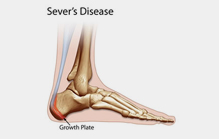
Sever’s Disease, also known as Calcaneal Apophysitis, is a painful bone disorder that results from inflammation (swelling) of the growth plate in the heel. A growth plate, also called an epiphyseal plate, is an area at the end of a developing bone where cartilage cells change over time into bone cells. As this occurs, the growth plates expand and unite, this is how bones grow.
Sever’s disease is a common cause of heel pain in growing kids, especially those who are physically active. It usually occurs during the growth spurt of adolescence, approximately a 2-3 year period in early puberty when kids grow most rapidly. This growth spurt can begin any time between the ages of 8 and 15, usually earlier for girls, a little later for boys.
Sever’s Disease Treatment
Sever’s disease treatment options range, some practitioners will tell you to stop playing sport, but given this condition can last for 2-3 years it is not always the best, or healthiest option. This news can also be quite devastating if your child loves sport. Some practitioners will recommend stretches, some tell you not to stretch because it will cause further irritation to the growth plate.
At the Melbourne Heel Pain Clinic we take this condition seriously. Sever cases that are not treated correctly can result in fracturing of the growth plate, loss of blood supply and can effect bone growth. It is a condition you need to get right and a condition that needs to be monitored.
How we diagnose it
A thorough physical examination is conducted to rule out other causes of heel pain, such as Plantar Fasciitis and Achilles Tendinitis. The range of movement in the ankle is also assessed to examine calf muscle tightness. Leg length discrepancy is also examined, as a longer leg compensates for the difference in length by taking more load during walking and running, thus placing more pressure on the foot.
This is followed by a gait analysis to examine foot function while the child is walking, and in some instances running.
A footwear assessment is also conducted to ensure shoes are appropriate and have adequate shock absorption in the heel.
In some instances, a referral for an X-ray is made.
